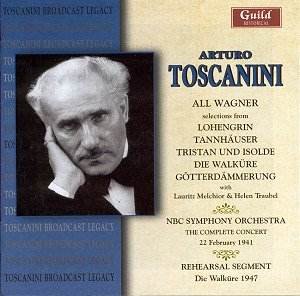Guild claims this to be the first time the complete
performance of this concert has been available commercially. As
a bonus, 20 minutes from an April 1947 rehearsal of Act 1 scene
3 of Die Walküre are added. Toscanini rehearsals were renowned
and always worth listening to, if only for the excitement of wondering
if one of his famous ‘explosions’ might be included!
Toscanini’s conducting of Wagner was inclined
to divide contemporary critics and has continued to do so, with
the ‘anti’ faction contending that his interpretations were too
‘Italianate’ and not sufficiently architectural. Certainly the
opening Lohengrin Prelude ‘CD1 tr.1’ is in no way sensuously melodic
in interpretation. The conductor builds from a very slow start,
where the violins do well to hold the legato line, to a climax
at around 6 mins, declining to the softest of finishes; certainly
architectural structuring to my ears. However, the matter of Toscanini
and tempi is more contentious. In a long and informed essay in
the booklet, William Youngren discusses the variety of tempi the
conductor adopted in different performances of a Wagner work.
He analyses three performances of the Lohengrin Prelude, finding
the one included here ‘as slow and spacious as the 1936 performance
but as dramatic and lyrical as that of the 1941’ (available on
Naxos Historical and RCA/BMG respectively). Youngren expresses
disappointment with the ‘Tristan’ Prelude, ‘CD1 tr.10’, and certainly
the performance is somewhat flat, perhaps a reaction to the vocal
items that had gone just before (in that respect I assume the
recording is sequenced as the original concert).
I suspect that it will be the vocal items that
will draw potential purchasers, particularly the presence of Helen
Traubel and Lauritz Melchior. Traubel, American by birth, gained
greatly by the polio that afflicted Marjorie Lawrence in 1941
and Flagstad’s retirement from the ‘Met’ the same year, the two
having shared the heavy Wagnerian soprano roles at that theatre
for the previous 6 years. Born in 1899, Traubel remained the leading
Wagnerian soprano at the ‘Met’ until 1953 when she fell out with
Rudolf Bing, the austere chief there, about her cabaret appearances!
Her Wagnerian credentials are clearly set out in ‘Dich, teure
Halle’, Elisabeth’s aria from Act 2 of Tannhaüser, ‘CD1 tr.3’,
when she starts appropriately joyously with clear declamation
and full tone before becoming more introspective. In the final
scene from Act 1 of ‘Die Walküre’, she is joined by the 50-year-old
Melchior, renowned as perhaps the greatest ‘heldentenor’ ever.
His strong voice, with light baritonal overtones, encompasses
every demand that Wagner makes in this highly dramatic scene as
the singers are matched by Toscanini’s grasp of the drama. Wagner
enthusiasts will enjoy comparing this performance with that conducted
by Leinsdorf on December 6th 1941 with the same duo
(Naxos Historical).
The second CD continues where the Die Walküre
finished, in terms of quality of performance as well as operatic
sequence, as we move to Götterdämmerung; the two singers
matching each other for dramatic thrust. Toscanini gives them
time to phrase, but without any loss of dramatic intensity. ‘Brünnhilde’s
Immolation’, trs.9-13, allows direct comparison with Flagstad
on Guild’s recent ‘Dream Cycle’ issue of the opera. Traubel may
not be the Norwegian’s equal, but who except Nilsson has bettered
her since?
Whatever one’s view of Toscanini and Wagner,
every lover of the composer’s work will want these well recorded
discs, not merely to enjoy for their own sake, but to compare,
contrast, and use to argue their particular viewpoint as to the
conductor’s interpretation of the composer’s work.
Robert J. Farr
